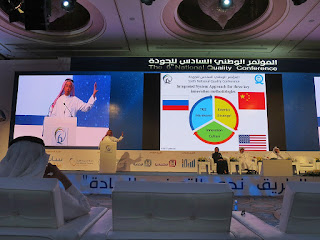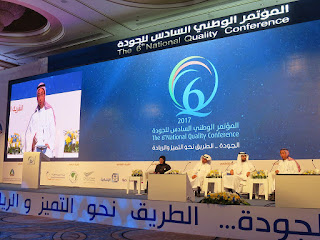The 6th National
Quality Conference (NQC) organized by Saudi Standards, Metrology and Quality
Organization (SASO) from 28th to 30th Nov 2017. It aims
to meet the updates and enhances the quality culture through spreading the
latest knowledge in this field. The slogan
of the Conference is “Quality ... the
path toward excellence and leadership” combines the main goal of the
Conference together with the latest updates in the current situation. During my session, I worn Saudi Arabia
traditional cloth “Thobe and Qotra” and took photo with Minda in the hall for
memory.
Day 2 (30th Nov 2017)
The keynote speaker was Prof.
Wan Seon Shin (Former President – Korean Society for Quality Management) and
his topic entitled “Korean Way for Excellence in Quality”. In the beginning, Prof. Shin compared
different cities/Countries from past to present including New York, Dubai,
Shanghai, Saudi Arabia, Nepal, Seoul, etc.
A huge change was observed.
Then he proposed the Quality
Slopes that would change your relative position after 5 years. Firstly, you needed to define your
performance goals and found out your slopes in attaining goals. The essence of growth in Korea was come from
Great Effort, Good Strategies, Good Leaders and Great Partners.
After that Prof. Shin mentioned what is Quality in Korea. The evolution is from “poor quality of management” to Quality equal to Safety, Profit, Creativity, Comfortable Living and Quality Responsibility. He proposed to make people think about the value of quality for Saudi’s 2030 vision. He stated the Korean Way for Excellence through “V” of Quality like Samsung.
Another
Quality Slope is Quality Strategies based on organizational culture. Then Prof. Shin introduced their National
Trade day and the 42nd National Quality Management Convention that
created 1446 National Quality Masters for Quality Leadership. He also briefed the Korean Customer
Satisfaction Index which involved manufacturing, national and service; as well
as Korean Standard Quality Excellence Index (KSQEI) for performance
measurement. The last Quality Slope is
finding differences.
Finally,
Prof. Shin introduced Quality Responsibility (Quality Goals) and Open Quality
(Quality Strategy). “Open Quality”
system key factors such as speed, creativity, data analytics, and AI are
combined to achieve “Quality + Quantity”.
Through open quality concept, he introduced the Quality Scorecard (QSC)
for assessing the quality of the existing performance measures. The Open Quality can build through M+T+C,
where
M:
Measurability (Fact based decision making and objective perspective)
T:
Traceability (Systematic collaboration and Root-causing prevention)
C:
Connectivity (Total value focused partnership and Balancing quality issue
through hyper connectivity)
At
the end, he concluded Korean Way for Excellence in Quality into four key items
below.
1.
Mind
Set
2.
Quality
Leaders
3.
Performance
Measures
4.
Differentiation
Forth Session – Best Practices in Quality and Business Excellence
(Chaired by HE Dr. Osamah Al Bar)
The first speaker was Mr. Sunil
Sinah (Resident Director - Tata Sons - Middle East & North Africa (MENA))
and his presentation named “Tata Business Excellence Journey – A Race without a
Finish Line”. He introduced the Tata Business Excellence
Model (TBEM) which made reference to Malcolm Baldrige National Quality Award
(MBNQA). Then he briefed their
Institutionalizing Excellence that commited to run the business ethically and
excellently. Moreover, Mr. Sinah shared
his company’s pioneer and established many “firsts” in Indian industry.
Finally,
Mr. Sinah shared three important supportive roles in strengthening the
competitiveness and could be made reference for Saudi Vision 2030.
1.
Improve
business excellence practices, capabilities and results
2.
Facilitates
communication with a common language of excellence and sharing of best
practices among Tata companies.
3.
Serves
as a working tool for understanding and managing performance, for providing
planning guidance, and for identifying learning opportunities.
The
second speaker was Mr. Mohammed Bin Suliman (Chairman of Education Evaluation
Commission, The United Arab Emirates) and his presentation was “Innovation in
development and delivery of customers services DEWA”. Firstly, he mentioned his king of Dubai
Mohammed bin Rashid Al Maktoum visions.
Then
he shared their experience of Water and Electricity Authority in developing and
presenting the creative ideas and how it helped in improving the services and
raising the customer happiness in addition to the role that played to decrease
the expenses. Finally, the video was
showed about their service as below.
The
third speaker in this session was Eng. Abdullah Al-Sodair (Operational
excellence management – ARAMCO) and he presented topic was “Saudi Aramco
Operational Excellence President’s Award”.
He shared the implementation of the operational excellence systems in
all ARAMCO's services which aimed to achieve the sustainable profits and
products that's why ARAMCO management has decided that the most efficient
employee in executing those systems would win the president's award for the
performance excellence.
During
the break, I return to hotel and met Eng. Mohammad AboHasnah (General Manager,
PDCA Management Consultancy, Abu Dhabi) and Mr. Ibrahim Ghaith (Management
Systems Consultant, PDCA Management Consultancy, Abu Dhabi). We took a photo for memory.
Fifth Session – Quality and
Innovation
(Chaired by HE Prof. Hisham Bin Saad Aljadhey)
Dr. Eva Diedrichs (Founding
Managing Director European Innovation Management Academy) was the first speaker
in the fifth session and her presentation title was “Innovation Management – A
Capacity that can be Measured and Learned”.
She firstly discussed the definition for innovation and innovation
management, and then mentioned how to measure innovation management
performance.
There were many definitions available
for innovation. One of that from Steve
Job she like was “Innovation distinguishes between leader and follower.” Then she showed us some definitions from
different standards such as CWA 15899, FD X50-271 and CEN/TS 16555-1. However, she said within ISO/TC 279 which
strongly focused to put on innovation as a means of value creation.
Then
Dr. Eva Diedrichs said companies needed to understand the relationship between
growth and managing innovation effectively.
She introduced the five key dimensions of innovation management on “House
of Innovation” (stated in workshop too).
She also suggested considering the relation between innovation
management capabilities and EBIT performance.
After that she stated their IMP3rove benchmarking database had
more than 7000 companies’ assessment results for benchmarking by different
industry sectors and sizes. Finally, she
concluded that excellence was a coin that had two sides. They were Quality and Innovation. (Excellence
= Quality + Innovation)
I (Dr. Lotto Lai, Chairman of
Hong Kong Society for Quality (HKSQ)) was the second speaker in the fifth
session and my topic entitled “Quality Innovation – Trend, Tools and Integrated
System Approach: A Case Study in Hong Kong”.
I mentioned that "Innovation is Quality for Tomorrow" which
was the title of ASQ Innovation Think Tank Executive Summary issued on 6th May
2013. Then I clarified what is the
meaning among “Quality and Innovation”, “Quality Innovation” and “Innovation
Quality”. Their common area is “Improvement”.
Then I briefed the evolution of
the Quality and Innovation tools since Industrial Revolution in 1800s. I highlighted some key innovation
tools/methodologies to discuss and they were Brainstorming, TRIZ, Extenics and
Innovation Culture.
I described the China Original
Science named “Extenics” as one of major parts in my presentation. Prof. Cai Wen was the founder of the Extenics
and his first paper named “Extension Set and Incompatible Problem” which issued
in 1983 (after 7 year research since 1976).
I had invited Prof. Cai Wen and his student Prof. Yang Chunyan to be
keynote speakers for the 1st World Summit for Chinese Quality on 8 July 2016 in
City University of Hong Kong.
Then I also introduced the
Extension Innovation Method (Prof. Yang Chunyan’s new book in 2017) especially
on 4 steps METS methodology and they were Model, Extension, Transformation and
Selection. The basic-element theory was
stated for the first step – Model and Divergence example used to explain the
second step –Extension. After that I
introduced the overall Extenics tools through the summary on Extension
Innovation Table.
Finally, I proposed to integrate
the TRIZ, Extenics and Innovation Culture for Quality Innovation in
organization. However, it needed a
framework to implement it. I also suggested
to use Quality Innovation Management System (QInnoMS) which integrated the ISO
9001:2015 and CEN/TS 16555-1 to -7.
Lastly, I shared four Hong Kong
Cases that were CLP Power Transformer Overhaul using TRIZ, Towngas Dream Zone
using TRIZ and creating Innovation Culture, HKSTP Quality Startup plus Extenics
and Baby First Education Group employed Extenics. Baby First Education Group was the first Hong
Kong Company received Prof. Cai Wen training workshop and adopt Extenics as
their program development philosophy. At
the end, I played Baby First’s short video to express creativity after Extenics
workshop.
(SASOGOV Twitter recorded my
part at https://twitter.com/SASOGOV/status/936156088684163072?s=03
and https://twitter.com/SASOGOV/status/936158305491324928?s=03
)
The third speaker in this
session was Prof. Abdullah Aljughiman (Member of Shura council and a lecturer
of creativity in king Faisal university, Al-Ahsa.) and his presentation topic
named “Quality is Innovation”. Prof.
Aljughiman discussed “Are the concepts and bases of Quality can be a basic
element to build a creative society?”
Prof. Aljughiman quoted IBM
survey about important leadership elements.
Then he discussed the organization life cycle. Finally, his researches and experiences
showed that the organizations which had achieved success on the long term and
had passed obstacles were mixing the quality and creativity together which
guaranteed successful results and continuation of the organizations.
Q&A in the fifth session
Dr. Saad bin Othman Al-Kasabi
(Governor of Saudi Standard, Metrology and Quality Organization (SASO))
presented souvenir to me.
During the break, we took photos
with our friends for memory.
Many speakers would like to take
a photo including Mr. Mike Turner, Prof. Wan Seon Shin and Dr. Eva Diedrichs,
etc.
Minda
and I took a photo with Saudi Arabia ladies who attended the conference.
Other
Saudi Arabia friends
Sixth Session – Quality and Future
Generation
(Chaired by Mr. Tarek Saad Al Mazhood)
Mr. Abdulaziz Khaled Baltyor discussed
“Distinguished Student in the secondary school”.
Mrs.
Manal Emad Al Sheikh spoke for Distinguished College Student
Mrs.
Zainab Ahmed Al-saffar (Clinical Quality Coordinator) presented “Distinguished
Young Technician”.
Eng.
Ibrahim Al-Saigh (Director of Department of Quality and Organizational
Excellence) discussed “Distinguished Quality Manager”.
Q&A in the sixth session
Closing Session
Dr.
Ayed Alamri (President of Saudi Quality Council) gave a closing speech and
summarized the conference achievement.
At
the end, I took a photo with Dr. Ayed Alamri for memory.
All
speakers are took a group photo with Dr. Ayed Alamri.
The
6th National Quality Conference in Dammam, Saudi Arabia was
completed successfully. After that we
took lunch together.
Reference:
The 6th National
Quality Conference (NQC) in Damman, Saudi Arabia - http://nqc.gov.sa/en/AboutUsPage.aspx




































沒有留言:
發佈留言